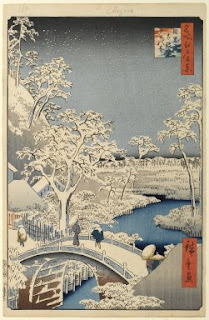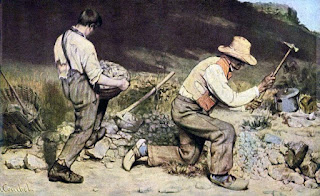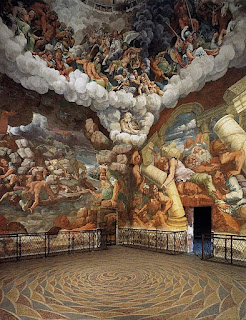Art in Japan - The Woodblock Print
The Edo Period/ Woodblock Prints -
The Edo period lasted from 1603 to 1868. During this time Japan was ruled by a feudal military government called the Tokugawa shogunate. This government controlled the country from the capital, Edo which is now called Tokyo. During the Tokugawa shogunate ruling they divided their people into four classes which were the samurai, farmers, artisans, and merchants. Due to this division and specifically having merchants as one of the four classes, that caused this country to create A nationwide trade and commerce market system that allowed merchants to sell and receive goods in order to create their own businesses and grow within the social hierarchy. Well now that the market system is booming, what could we sell? Well that’s when Japanese woodblock prints also known as ukiyo-e prints became a popular selling item. These prints became a hot item within the market because now that people had money to spend on entertainment and activities, these Japanese woodblock prints were offered as a way to enjoy art without spending tons of money. The reason why these prints are so affordable is because they are mass produced pieces of art. Other than household pieces of art ukiyo-e prints were also used to feature sumo wrestlers, famous actors, political figures and commentary, and so much more. These things are the modern day laser printer. Now that time has passed and technology has evolved, we've stepped away from Japanese woodblock prints and are more focused on using technology to print art or anything that I listed above. Although you still will find people practicing woodblock printing due to their heritage, you typically will find that on local street corner businesses in Japan (not as popular).
This first piece of art is a Japanese woodblock print called The Meguro Drum Bridge and Sunset Hill. It was created in Japan in 1857 during the Edo period. The artist's name is Utagawa Hiroshige, and The purpose behind his print is to celebrate one of the main attractions in the Meguro area, which is the bridge. The reason why the drum bridge is a main attraction is because A stone arched bridge was quite unusual during This time because since the city is so prone to earthquakes this type of bridge isn’t designed to hold up well when one is happening. My favorite part of this painting is how well the artist captured a cozy winter atmosphere by adding people, The different shades of blue and white, and how it isn’t exactly realistic. It reminds me of a cozy movie. With that being said, I would love to own this print, especially hanging it up during winter. I think that would make the atmosphere of the home even more cozy.
The second piece is another woodblock print called, The Great Wave of Kanagawa. This print was created by Katsushika Hokusai in 1831. This is a very famous print that most people recognize and personally I would say is one of the most famous pieces of art of all time. Hokusai was a very popular artist during the era., He sold many many prints during this time and lucky enough this print popularly took off and was sold all over the world. Its purpose behind this photo of many other pieces of his is to capture the power and beauty of nature. From looking at this photo you can definitely see the powerful energy radiating from this print starting from the iconic Mount Fuji in the back, the large powerful wave getting ready to crash down on the men inside of the boat throwing against this force of nature. The artist's use of depth and dimension works in his favor with this piece because of the intricate use of contrast between the background and the main picture. Overall, I wouldn’t necessarily omit this print, I think it’s an amazing piece and it deserves its recognition but I don’t know where I would put it that would truly fit within my home.
Last but not least, this third Japanese woodblock print I believe is calledŌtani Oniji III in the Role of the Servant Edobei created by Tōshūsai Sharaku created in 1794. Sharaku is a well known ukiyo-e print designer that mostly dabbled in creating yakusha-e portraits (woodblock) of kabuki actors. within the print he likes to express emotions like anger, sadness, joy, and etc. he also does not try to shy away from unflattering details, I don’t necessarily know why, a lot of people don’t know, they think that that is just his style of art although he never had apprenticeship like his fellow artists. The reason why I chose this piece is because it’s so oddly fascinating and honestly kind of makes me uncomfortable. The expression coming off of him as well as his odd hand placement makes this such a weird piece. What I do enjoy from this print is how detailed the lines are and his use of color, the way he does the lines on his head makes it look like his hair is shining, as well as his kimono or shawl the lines on there make it look like it’s flowing correctly. As you can probably tell, I don’t think I would want to own this piece because I think this print would haunt me but it sure is a fascinating piece of art!
Citation List
“The Great Wave Off Kanagawa.” Wikipedia, Wikimedia Foundation, 3 Apr. 2023, https://en.wikipedia.org/wiki/The_Great_Wave_off_Kanagawa.
“Sharaku.” Wikipedia, Wikimedia Foundation, 24 Feb. 2023, https://en.wikipedia.org/wiki/Sharaku.
“Meguro Drum Bridge and Sunset Hill, No. 111 from One Hundred Famous Views of Edo.” Brooklyn Museum, https://www.brooklynmuseum.org/opencollection/objects/121723.






Hi Laney, while I had seen some of the art works you shared in your post I was unfamiliar wiht they hisoty and woodblock printing. I agree with your discomfort towards Oniji III. The facial expression is soemthing I would jump at if I saw it in the daek with no context. I would own art work in this style and would prefer the scenic prints.
ReplyDeleteI really like Ukiyo-e, I talked about it on my blog post. Since it has inspired some art movements around the world. Like superflat style in Murakami's art.
ReplyDeleteBut probably, the influence that I like about the most is the European impressionists. You can see some of this prints being represented by Van Gogh on his paintings, and the use of lines, and colors heavily influence this generation of artists.
I actually really like Ōtani Oniji III, I think its a great caricature and fun print. Since he was a Kabuki actor, this print might had been sued as advertisement for a play or for the actor himself. I like to think that it resembles an early 2010 youtube thumbnail, where the yutubers would choose the most goofy face for the cover of their videos to try to get more views...
Hi Laney, I really like The Great Wave of Kanagawa and talked about on my blog post. Although this piece shows a terrible situation about to happen, it is still a beautiful piece of artwork. I really liked how he was able to put so much detail into the waves that they look realistic. Thank you for sharing!
ReplyDelete